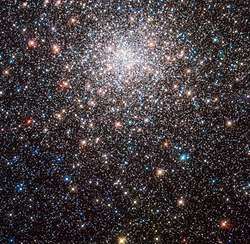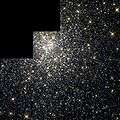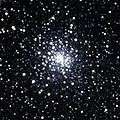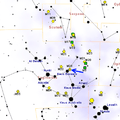Messier 28
Messier 28 or M28, also known as NGC 6626, is a globular cluster of stars in the constellation Sagittarius. It was discovered by French astronomer Charles Messier on July 27, 1764.[9] He briefly described it as a "nebula containing no star... round, seen with difficulty in 3½-foot telescope; Diam 2′." The 2′ at the end indicates an angle of two arcminutes.[10]
| Messier 28 | |
|---|---|
 | |
| Observation data (J2000 epoch) | |
| Class | IV[1] |
| Constellation | Sagittarius |
| Right ascension | 18h 24m 32.89s[2] |
| Declination | –24° 52′ 11.4″[2] |
| Distance | 17.9 kly (5.5 kpc)[3] |
| Apparent magnitude (V) | +7.66[2] |
| Apparent dimensions (V) | 11′.2[4] |
| Physical characteristics | |
| Mass | 5.51×105[3] M☉ |
| Radius | 30 ly[5] |
| VHB | 15.55 ± 0.10[6] |
| Metallicity | = –1.32[3] dex |
| Estimated age | 12.0 Gyr[7] |
| Notable features | Contains first pulsar discovered in a globular[8] |
| Other designations | GCl 94, M 28, NGC 6626[2] |
In the sky it is less than a degree to the northwest of the 3rd magnitude star Kaus Borealis. This cluster is faintly visible as a hazy patch with a pair of binoculars[9] and can be readily found in a small telescope with a 8 cm (3.1 in) aperture, showing as a nebulous feature spanning 11.2 arcminutes. At 15 cm (5.9 in), the core becomes visible and a few individual stars can be resolved along the periphery. Larger telescopes will provide greater resolution,[4] with a 25 cm (9.8 in) telescope revealing a 2′ core.[9]
M28 is at a distance of about 17,900 light-years away from Earth.[3] It has a combined 551,000[3] times the mass of the Sun and is 12 billion years old.[7] 18 RR Lyrae type variable stars have been observed in this cluster. In 1986, M28 became the first globular cluster where a millisecond pulsar, PSR B1821–24, was discovered with the Lovell Telescope at Jodrell Bank Observatory.[8] A total of 11 additional millisecond pulsars have since been detected in the cluster with the Green Bank Telescope at Green Bank Observatory. As of 2011, this is the third largest known population of pulsars in a cluster following Terzan 5 and 47 Tucanae.[11]
Gallery

 2.5' view of M28 taken by Hubble Space Telescope.
2.5' view of M28 taken by Hubble Space Telescope. Messier 28 on 2MASS; wide angle
Messier 28 on 2MASS; wide angle Map showing location of M28 (Roberto Mura)
Map showing location of M28 (Roberto Mura)
References
- Shapley, Harlow; Sawyer, Helen B. (August 1927), "A Classification of Globular Clusters", Harvard College Observatory Bulletin, 849 (849): 11–14, Bibcode:1927BHarO.849...11S.
- "M 28". SIMBAD. Centre de données astronomiques de Strasbourg. Retrieved 2006-11-16.
- Boyles, J.; et al. (November 2011), "Young Radio Pulsars in Galactic Globular Clusters", The Astrophysical Journal, 742 (1): 51, arXiv:1108.4402, Bibcode:2011ApJ...742...51B, doi:10.1088/0004-637X/742/1/51.
- Inglis, Mike (2004), Astronomy of the Milky Way: Observer's guide to the northern sky, Patrick Moore's Practical Astronomy Series, 1, Springer, p. 21, Bibcode:2003amwn.book.....I, ISBN 978-1852337094.
- From trigonometry: radius = distance × sin( diameter_angle / 2 ) = 30 ly
- Testa, Vincenzo; et al. (February 2001), "Horizontal-Branch Morphology and Dense Environments: Hubble Space Telescope Observations of Globular Clusters NGC 2298, 5897, 6535, and 6626", The Astronomical Journal, 121 (2): 916–934, Bibcode:2001AJ....121..916T, doi:10.1086/318752
- Koleva, M.; et al. (April 2008), "Spectroscopic ages and metallicities of stellar populations: validation of full spectrum fitting", Monthly Notices of the Royal Astronomical Society, 385 (4): 1998–2010, arXiv:0801.0871, Bibcode:2008MNRAS.385.1998K, doi:10.1111/j.1365-2966.2008.12908.x
- "JBO - Stars". Jodrell Bank Observatory. Retrieved 2007-06-01.
- Thompson, Robert Bruce; Thompson, Barbara Fritchman (2007), Illustrated Guide to Astronomical Wonders, Diy Science, O'Reilly Media, Inc., p. 402, ISBN 978-0596526856.
- Burnham, Robert (1979), Burnham's celestial handbook: an observer's guide to the universe beyond the solar system, Dover books explaining science, 3 (2nd ed.), Dover Publications, p. 1609, ISBN 978-0486236735
- Bogdanov, Slavko; et al. (April 2011), "Chandra X-ray Observations of 12 Millisecond Pulsars in the Globular Cluster M28", The Astrophysical Journal, 730 (2): 81, arXiv:1101.4944, Bibcode:2011ApJ...730...81B, doi:10.1088/0004-637X/730/2/81
- "Nebulous, but no nebula". www.spacetelescope.org. Retrieved 11 March 2019.
External links
| Wikimedia Commons has media related to Messier 28. |
